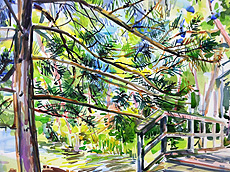Artwork of NIU professors on exhibit in Fermilab Art Gallery
 |
| Charlotte Rollman's "Walking Path" is currently on display in the Fermilab Art Gallery. |
As you take in the paintings, prints and sculptures currently on display in the Fermilab Art Gallery, you will see views of landscapes real and imagined, of scenes unreal and affecting.
The new exhibit, titled "VIEWS," shows works of four art professors from Northern Illinois University. An artist reception will take place in the gallery on Friday, Sept. 20, beginning at 5 p.m.
Harry Wirth's experimental landscapes are from a series of paintings called "Imaginary Spaces." Although Wirth uses only a minimum of shapes and lines — simple washes and bands of color — to depict the scene, his approach to the landscapes is far from simplistic. They are the culmination of many visual experiences.
"I just cleaned the palette completely, starting from scratch to do what I always wanted to do: deal with landscape imagery on an experimental and imaginary level," he said. Rather than representing actual scenes, the series' landscapes are born of the imagination. "I sort of put together all these little postcard pictures that I have in my brain and let those images flow onto the paper."
His spontaneous, free-form landscapes also include paintings in which only parts of a scene are shown — the part you might see while looking through a window frame. In the painting, the window frame is shown as blank, unpainted paper, a sharp-edged nothingness blocking out the scenery, letting the viewer's imagination do the rest.
Artist Charlotte Rollman also lets the paper show through in her watercolor paintings, thus allowing colors to advance that much more strongly, bringing the scenes to life.
"It's sort of like drawing and leaving the white of the paper — it energizes the color," Rollman said. "I actually like color so much that it feels like a real thing to me. It's not just a palette or a name. It's a three-dimensional thing that reflects light and life."
Her vivid impressionist-style paintings of the outdoors show scenes from all over the country: Dubuque, the Mississippi River, Rocky Mountain National Park.
Also on display in "VIEWS" are Ashley Nason's surreal prints of animals and everyday objects set in a deliberately, yet seemingly haphazardly, arranged settings. Sculptor Yih-Wen Kuo abstracts the traditional understanding of a vessel to an exploration of empty and occupied space.
Artists showing in the exhibit will be at Friday's reception to chat with attendees. All are welcome.
—Leah Hesla
|